Below is a MAP of all the rest of the T. taxifolia specimens, more than 100 yards east of the 2 largest specimens shown in the photos above. All specimens are shown in red, labelled A to S. The 3 specimens bearing "fruit" are circled in black: Specimens C, D, and S.
Next to the map is a table of stem circumferences (inches at breast height) keyed to each lettered specimen, A to S. The three specimens bearing fruit are shown in green. The surviving original plantings (surmised to be 22 inches girth or greater; the only specimen that bears a tag as an original is 25" in girth) are shown in blue. It is disappointing to note that none of the original specimens in this grove bear fruit. Many, of course, may be male. It is also disappointing that the two smallest specimens I could find had a 7-inch and a 3-inch girth; whereas during my 2002 visit I noted a number of seedlings to the west (left on map) of Specimen S.
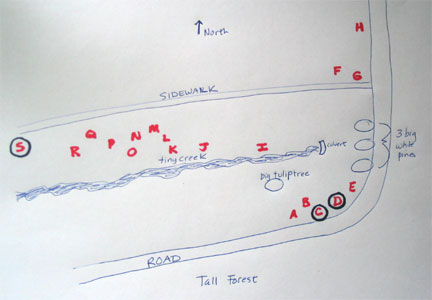 |
|
A - 3"
B - 8"
C - 7" (1 fruit, full-size)
D - 8" (1 fruit, full-size)
E - 8"
F - 30" (unhealthy; branches on
one side nearly leafless)
G - 27"
H - 13"
I - 8"
J - 30"
K - 17"
L - 25"
M - 28"
N - 22"
O - 24"
P - 29"
Q - 8"
R - 29"
S - 8" (21 seeds, but half of those
are dwarf in size)
|
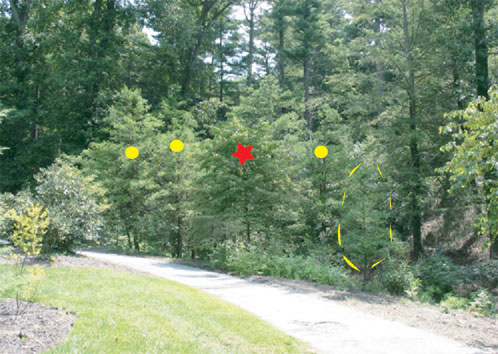 11
11
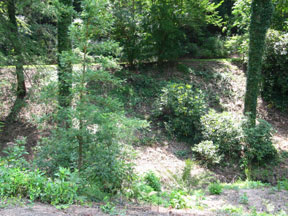 12
12
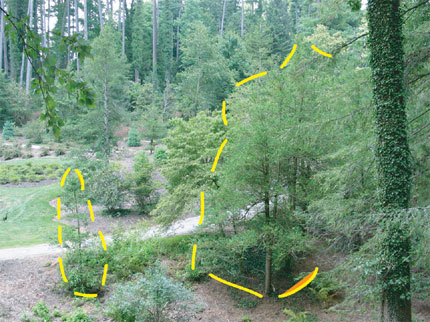 12x
12x
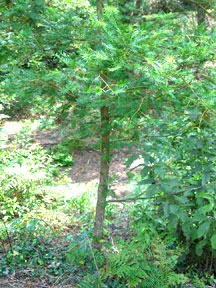 13
13
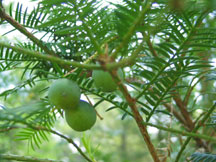 14
14
PHOTO 11 shows, encompassed by a drawn yellow outline, Specimen S (the 8"-girth tree bearing 21 fruit). A dogwood is marked by the red star. Yellow dots show the locations of what are probably specimens R, N, and M.
PHOTO 12 shows the fruit-bearing Specimen S at left foreground. Even though the branches are rather open and sparse, the foliage looks healthy. This individual gets a lot of summer sun. But because the slope across the road (visible as flat plane in background) is steep and tall, I suspect that no direct sun strikes any of the trees in this location during the months around Winter Solstice.
PHOTO 12x, taken from the road, shows a view of Specimen S (outlined in yellow on left) from the opposite viewpoint as in photo 12. The grove of Specimens K through R is indicated on the right. At far right foreground, hemlock branches dangle.
PHOTO 13 is a close-up of Specimen S lower stem, and PHOTO 14 shows a group of three of its full-size fruits.
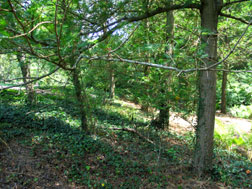 15
15
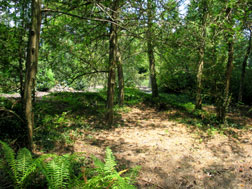 16
16
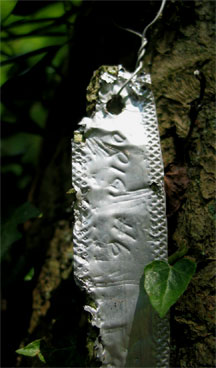 16x
16x
PHOTO 15 shows specimens R and Q in foreground. The left-most stem is dogwood. Several more T. tax visible behind.
PHOTO 16 is from standing to the south and seeing the "line" of specimens R and Q on the left, then looking north (center right) into the semi-circular group of K, L, M, N, and O. White sidewalk is visible in the background. None of the Torreya specimens in this photo are bearing fruit. Are they all males, or are they too stressed to bear fruit? The right-most tree (Specimen K) is the only one in this entire section that bears a tag.
PHOTO 16x shows the tag of this Specimen K, with a 25-inch girth. The tag reads, "ORIG #6", and it appears very old.
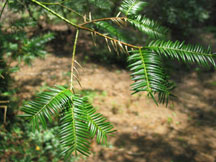 17
17
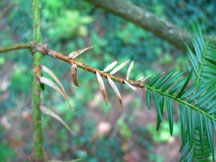 18
18
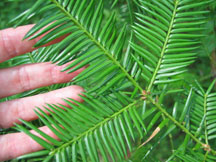 18x
18x
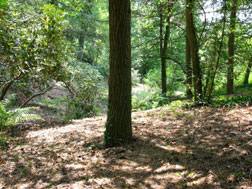 19
19
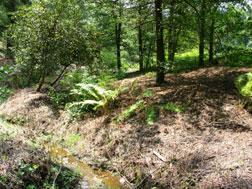 20
20
PHOTOS 17 & 18 show the most-stressed foliage I could find in this I through R grove. Compare it with the lovely foliage in PHOTO 18x, which is Specimen C on the other side of the small creek.
PHOTO 19 is Specimen J, with a 30-inch girth. The creek is behind it.
PHOTO 20 shows the creek in foreground with Specimen J upslope and beyond it, and the group of J through R beyond that. None of the Torreya stems visible in this photo are bearing fruit.
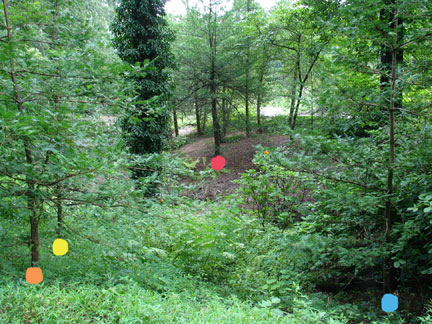 21&
21&
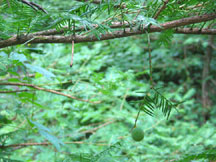 22
22
PHOTO 21 was taken while standing on the road. Pink dot marks Specimen J in background; the vine-covered big trunk mid-ground is a big tuliptree. Foreground dots mark the vibrant young trees right next to the road, and where the underbrush in entirely unmanaged. It is surprising how vibrant these young trees are, given how little sun reaches this spot. The yellow dot marks Specimen B; orange is Specimen C; blue is Specimen D. C and D each bear one fruit, and have girths of 7 inches and 8 inches, respectively. Because 7 of the 10 specimens that are clearly not the originals have girths of 7 or 8 inches, it would be interesting to know whether these represent a single year's crop of seedlings that Biltmore staff planted or transplanted all at once — and when that year would have been.
PHOTO 22 shows Specimen D's lone, dangling fruit.
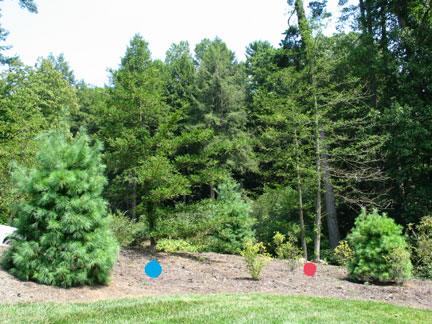
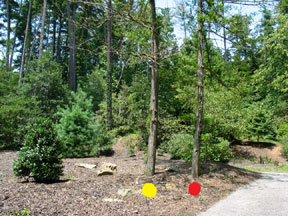 24
24
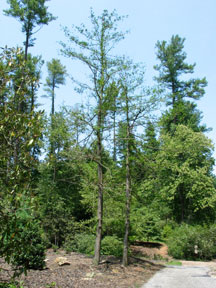 25
25
PHOTO 23 is the view looking SW at Specimens F, G, and H. The paved road is just beyond them. The turquoise dot marks the healthy young Specimen H, which has a girth of 13 inches. The pink dot marks two nearby, but clearly separate, individuals that are surely part of the original 1939 planting, as they are 27 and 30 inches in girth. Both are stressed, but the one on the right in this photo has a lot of dead branches, all the way to the top, on the right-most side, and the lower (presumably dead) branches have been cut. None of these specimens is bearing fruit, and none has stump sprouts growing to take over if the main stem dies entirely.
PHOTO 24 shows in yellow and red the 2 individuals demarcated by pink in the previous photograph. The yellow dot marks Specimen F, which clearly is dying (two entirely dead branches are visible about 8 feet up the trunk; scars from lower branches that have been cut are somewhat visible). In PHOTO 25 you can see the nearly barren top of that tree, along with a stressed rhododendron in the foreground left.
Notice the young white pines in PHOTO 23. These are new plantings. When the author of this page visited the site 4 years earlier, this section was a mix of tall, old pines in the high canopy and Torreya specimens as the lower canopy. The Biltmore reports that the broken stems and otherwise weakened and degraded condition of some of the original trees is due to the devastation by hurricanes Francis and Ivan in September 2004. The estate lost hundreds, if not thousands of large trees due to the saturated ground and high winds. Dozens of large pines in the adjacent groves were either uprooted and/or broken. Biltmore arborists had to
remove additional ones that had become safety hazards. After having grown
under the pines for decades, the Torreyas have experienced sun scald and
stress from drier soil since the canopy was opened.
New Archival Information
on Original Biltmore Plantings
(contributed by Bill Alexander, October 2005)
Biltmore archival records show that Torreya taxifolia was originally brought to the Biltmore in 1896-97 and was growing at the Arnold Arboretum at that time also. In the "Biltmore Nursery Dept. Outgoing Correspondence, Vol. I 1896-1897"
there is a letter on p. 219 from C. Beadle to Prof. C. S. Sargent, Arnold
Arboretum. Beadle mentions having received from a correspondent of his in
Bristol, Florida,
"a few plants each of Torreya taxifolia and Taxus
floridana. I am quite interested to know if this latter species has ever
been in cultivation. I know that the Torreya has; indeed, you have it at the
Arnold Arboretum. If you have not plants of Taxus floridana, we will be
pleased to send you some as soon as our stock is sufficently advanced to
warrant the shipment."
The letter continues with Beadle talking more about exchanging plants. The records indicate (p. 908) that on 4 March 1897 Beadle sends Sargent specimens of Taxus floridana.
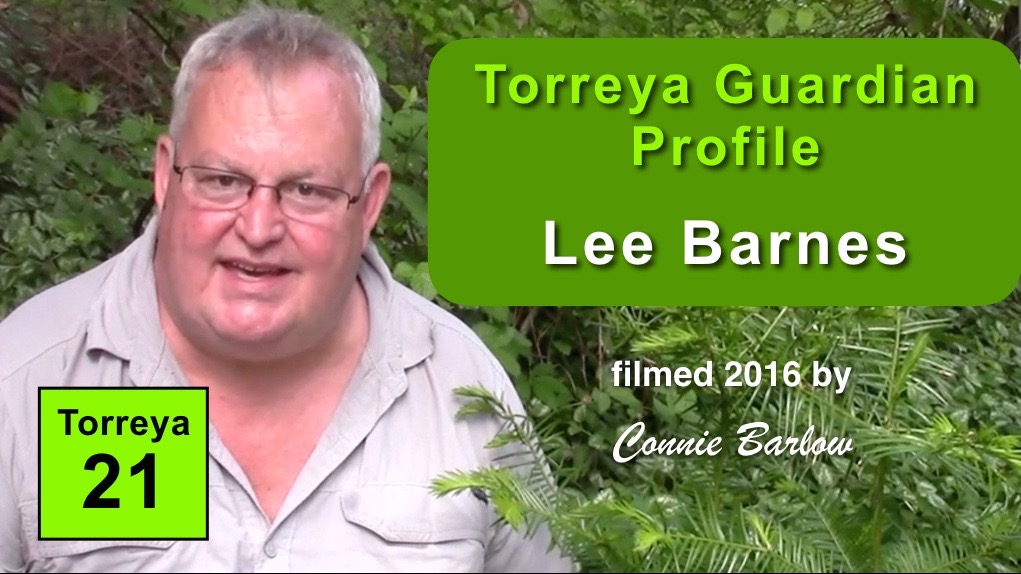 |
|
2016 VIDEO: Early history of Torreya Guardians (by Lee Barnes)
Lee Barnes is a founding Torreya Guardian, with the longest tenure of work with Torreya taxifolia. From 1981-85 his graduate research entailed advanced propagation techniques for three endangered plants in Torreya State Park of Florida — Torreya among them. Here Lee speaks of his research and his early role in securing Torreya seeds from Biltmore forest historian Bill Alexander for distribution to volunteer planters. |
2016 UPDATE ON SEEDS FROM THE BILTMORE: November 28, 2016 email from Lee Barnes: "... Biltmore Estate offered to send us 7 seeds that I am having them send to Jack." Editor's note: Lee returned to the Biltmore to ask for seeds because we lost our usual (prolific) seed source donor this year.
|